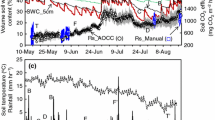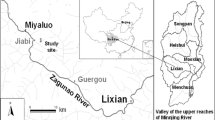Abstract
Soil CO2 efflux from an ecosystem responds to the active layer thawing depth (H) significantly. A Li-8100 system was used to monitor the CO2 exchange from a wet meadow ecosystem during a freeze–thaw cycle of the active layer in a permafrost region on the Qinghai-Tibet Plateau. An exponential regression equation (\( F_{\text{soil\, flux}} = 1.84e^{0.023H} + 5.06\,R^{2} = 0.96 \)) has been established on the basis of observed soil CO2 efflux versus the thawed soil thickness. Using this equation, the total soil CO2 efflux during an annual freeze–thaw cycle has been calculated to be approximately 8.18 × 1010 mg C. The results suggest that freeze–thaw cycles in the active layer play an important role in soil CO2 emissions and that thawed soil thickness is the major factor controlling CO2 fluxes from the wet meadow ecosystem in permafrost regions on the Qinghai-Tibet Plateau. It can be concluded that with active layer thickening due to permafrost degradation, massive amounts of soil carbon would be emitted as greenhouse gases, and the permafrost region would become a carbon source with a positive feedback effect on climate warming. Hence, more attention should be paid to the influences of the active layer changes on soil carbon emission from these permafrost regions.








Similar content being viewed by others
References
Amundson R (2001) The carbon budget in soils. Annu Rev Earth Planet Sci 29:535–562
Chapin FS III, Sturm M, Serreze MC et al (2005) Role of land-surface changes in Arctic summer warming. Science 310:657–660
Christensen TR, Johansson T, Akerman JH et al (2004) Effects on vegetation and methane emissions. Geophys Res Lett 31:L04501
Davidson EA, Janssens IA (2006) Temperature sensitivity of soil carbon decomposition and feedbacks to climate change. Nature 440(7081):165–173
Elberling B (2007) Annual soil CO2 effluxes in the High Arctic: the role of snow thickness and vegetation type. Soil Biol Biochem 39:646–654
Elberling B, Brandt KK (2003) Uncoupling of microbial CO2 production and CO2 release in frozen soil and its implications for field studies of Arctic C cycling. Soil Biol Biochem 35:263–272
Fang C, Moncrieff JB (2001) The dependence of soil CO2 efflux on temperature. Soil Biol Biochem 33:155–165
Guglielmin M, Ellis-Evans JC, Cannone N (2008) Active layer thermal regime under different vegetation conditions in permafrost areas-a case study at Signy Island (Maritime Antarctica). Geoderma 144:73–85
Guo WH, Li B, Zhang XS et al (2003) FDR system and its application in the sequential dynamical measurement of soil moisture content. Arid zone Res 20(4):247–251
Hinzman LD, Bettez ND, Bolton WR et al (2005) Evidence and implications of recent climate change in northern Alaska and other Arctic regions. Clim Change 72:251–298
IPCC (Intergovernmental Panel on Climate Change) (2007) Climate change 2007: the scientific basis. IPCC, Geneva
Jorgenson MT, Racine AB, Walters JC et al (2001) Permafrost degradation and ecological changes associated with a warming in central Alaska. Clim Change 48:551–579
Kato T, Hirota M, Tang YH et al (2005) Strong temperature dependence and no moss photosynthesis in winter CO2 flux for a Kobresia meadow on the Qinghai-Tibetan Plateau. Soil Biol Biochem 37:1966–1969
Kellman L, Beltrami H, Risk D (2007) Changes in seasonal soil respiration with pasture conversion to forest in Atlantic Canada. Biogeochemistry 82:101–109
Larsen KS, Jonasson S, Michelson A (2002) Repeated freeze–thaw cycles and their effects on biological processes in two Arctic ecosystem types. Appl Soil Ecol 21:187–195
Lin Q, Jin HJ, Cheng GD et al (1996) CH4 and CO2 emission from permafrost surface in Wudaoliang in the Tibetan Plateau. J Glaciol Geocryol 18(4):325–330
Mikan C, Schimel J, Doyle A (2002) Temperature controls of microbial respiration above and below freezing in Arctic tundra soils. Soil Biol Biochem 34:1785–1795
Nordstroem C, Soegaard H, Christensen TR et al (2001) Seasonal carbon dioxide balance and respiration of a High Arctic fen ecosystem in NE-Greenland. Theor Appl Climatol 70:149–166
Oechel WC, Hastings SJ, Vourlitis GL et al (1993) Recent change of Arctic tundra ecosystems from a net carbon dioxide sink to a source. Nature 361:520–523
Osterkamp TE (2005) The recent warming of permafrost in Alaska. Glob Planet Change 49:187–202
Polyakov I, Akasofu S, Bhatt U et al (2002) Trends and variations in Arctic climate system. Eos Trans AGU 83(46):547–548
Raich JW, Schlesinger WH (1992) The global carbon dioxide flux in soil respiration and its relationship to vegetation and climate. Tellus B 44:81–99
Rodionow A, Flessa H, Kazansky O et al (2006) Organic matter composition and potential trace gas production of permafrost soils in the forest tundra in northern Siberia. Geoderma 135:49–62
Skogland T, Lomeland S, Goksøyr J (1988) Respiratory burst after freezing and thawing of soil: experiments with soil bacteria. Soil Biol Biochem 20:851–856
Walker DA, Jia GJ, Epstein HE et al (2003) Vegetation-soil-thaw-depth relationships along a low-Arctic bioclimate gradient, Alaska: synthesis of information from the ATLAS studies. Permafr Periglac Process 14:103–123
Wang GX, Cheng GD (2001) Characteristics of grassland and ecological changes of vegetations in the sources regions of Yangtze and Yellow rivers. J Desert Res 21(2):101–107
Wang GX, Cheng GD, Shen YP (2002) Soil organic carbon pool of grassland soils on the Qinghai-Tibetan Plateau and its global implication. Sci Total Environ 291(1–3):207–217
Wang GX, Li YS, Wang YB et al (2008) Effects of permafrost thawing on vegetation and soil carbon pool losses on the Qinghai-Tibet Plateau, China. Geoderma 143:143–152
Wang JF, Wang GX, Hu HC et al (2010) The influence of degradation of the swamp and alpine meadows on CH4 and CO2 fluxes on the Qinghai-Tibetan Plateau. Environ Earth Sci 60:537–548
Weller G, Chapin FS, Everett KR et al (1995) The arctic FLUX study: a regional view of gas release. J Biogeogr 22:365–374
Wu HB, Guo ZT, Peng CH (2003) Distribution and storage of soil organic carbon in China. Glob Change Biol 9(3):305–315
Zhao L, Li YN, Zhao XQ et al (2005) Comparative study of the net exchange of CO2 in types of vegetation ecosystems on the Qinghai-Tibetan Plateau. Chin Sci Bull 50(16):1767–1774
Zhao YH, Zhao L, Wu TY (2006) Variation of CO2 concentration in active layer in Beiluhe permafrost region of the Tibetan Plateau during winter and spring. J Glaciol Geocryol 28(2):183–190
Acknowledgments
This study was supported by the Natural Science Foundation of China (No. 41003032), the Global Change Research Program of China (2010CB951402), the West Light Foundation of the Chinese Academy of Sciences (No. Y028721), and the Research Project of the State Key Laboratory of Frozen Soil Engineering (No. SKLFSE-ZQ-05).
Author information
Authors and Affiliations
Corresponding author
Rights and permissions
About this article
Cite this article
Wang, J., Wu, Q. Annual soil CO2 efflux in a wet meadow during active layer freeze–thaw changes on the Qinghai-Tibet Plateau. Environ Earth Sci 69, 855–862 (2013). https://doi.org/10.1007/s12665-012-1970-y
Received:
Accepted:
Published:
Issue Date:
DOI: https://doi.org/10.1007/s12665-012-1970-y




